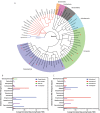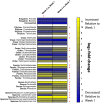Rapid metagenomics analysis of EMS vehicles for monitoring pathogen load using nanopore DNA sequencing
- PMID: 31339905
- PMCID: PMC6655686
- DOI: 10.1371/journal.pone.0219961
Rapid metagenomics analysis of EMS vehicles for monitoring pathogen load using nanopore DNA sequencing
Abstract
Pathogen monitoring, detection and removal are essential to public health and outbreak management. Systems are in place for monitoring the microbial load of hospitals and public health facilities with strategies to mitigate pathogen spread. However, no such strategies are in place for ambulances, which are tasked with transporting at-risk individuals in immunocompromised states. As standard culturing techniques require a laboratory setting, and are time consuming and labour intensive, our approach was designed to be portable, inexpensive and easy to use based on the MinION third-generation sequencing platform from Oxford Nanopore Technologies. We developed a transferable sampling-to-analysis pipeline to characterize the microbial community in emergency medical service vehicles. Our approach identified over sixty-eight organisms in ambulances to the genera level, with a proportion of these being connected with health-care associated infections, such as Clostridium spp. and Staphylococcus spp. We also monitored the microbiome of different locations across three ambulances over time, and examined the dynamic community of microorganisms found in emergency medical service vehicles. Observed differences identified hot spots, which may require heightened monitoring and extensive cleaning. Through metagenomics analysis it is also possible to identify how microorganisms spread between patients and colonize an ambulance over time. The sequencing results aid in the development of practices to mitigate disease spread, while also providing a useful tool for outbreak prediction through ongoing analysis of the ambulance microbiome to identify new and emerging pathogens. Overall, this pipeline allows for the tracking and monitoring of pathogenic microorganisms of epidemiological interest, including those related to health-care associated infections.
Conflict of interest statement
The authors have declared that no competing interests exist.
Figures



Similar articles
-
Freshwater monitoring by nanopore sequencing.Elife. 2021 Jan 19;10:e61504. doi: 10.7554/eLife.61504. Elife. 2021. PMID: 33461660 Free PMC article.
-
The Emergency Medical Service Microbiome.Appl Environ Microbiol. 2018 Feb 14;84(5):e02098-17. doi: 10.1128/AEM.02098-17. Print 2018 Mar 1. Appl Environ Microbiol. 2018. PMID: 29222105 Free PMC article. Review.
-
Metagenomic characterization of ambulances across the USA.Microbiome. 2017 Sep 22;5(1):125. doi: 10.1186/s40168-017-0339-6. Microbiome. 2017. PMID: 28938903 Free PMC article.
-
Real-time analysis of nanopore-based metagenomic sequencing from infected orthopaedic devices.BMC Genomics. 2018 Sep 27;19(1):714. doi: 10.1186/s12864-018-5094-y. BMC Genomics. 2018. PMID: 30261842 Free PMC article.
-
Nanopore Sequencing and Its Clinical Applications.Methods Mol Biol. 2020;2204:13-32. doi: 10.1007/978-1-0716-0904-0_2. Methods Mol Biol. 2020. PMID: 32710311 Review.
Cited by
-
Is Oxford Nanopore sequencing ready for analyzing complex microbiomes?FEMS Microbiol Ecol. 2021 Mar 10;97(3):fiab001. doi: 10.1093/femsec/fiab001. FEMS Microbiol Ecol. 2021. PMID: 33444433 Free PMC article.
-
RAPiD: a rapid and accurate plant pathogen identification pipeline for on-site nanopore sequencing.PeerJ. 2024 Sep 25;12:e17893. doi: 10.7717/peerj.17893. eCollection 2024. PeerJ. 2024. PMID: 39346055 Free PMC article.
-
Nanopore-Based Surveillance of Zoonotic Bacterial Pathogens in Farm-Dwelling Peridomestic Rodents.Pathogens. 2021 Sep 13;10(9):1183. doi: 10.3390/pathogens10091183. Pathogens. 2021. PMID: 34578215 Free PMC article.
-
Metagenomic Analysis of the Faecal Microbiome of Rats with 1, 2-Dimethylhydrazine Induced Colon Cancer and Prophylactic Whole-Cell Carotenoid Intervention.Indian J Microbiol. 2021 Mar;61(1):38-44. doi: 10.1007/s12088-020-00909-z. Epub 2020 Oct 7. Indian J Microbiol. 2021. PMID: 33505091 Free PMC article.
-
Human microbiome and microbiota identification for preventing and controlling healthcare-associated infections: A systematic review.Front Public Health. 2022 Dec 1;10:989496. doi: 10.3389/fpubh.2022.989496. eCollection 2022. Front Public Health. 2022. PMID: 36530685 Free PMC article.
References
-
- World Health Organization. Managing meningitis epidemics in Africa: a quick reference guide for health authorities and health-care workers. Geneva, Switzerland: World Health Organization; 2015. - PubMed
-
- Weber DJ, Rutala WA, Miller MB, Huslage K, Sickbert-Bennett E. Role of hospital surfaces in the transmission of emerging health care-associated pathogens: norovirus, Clostridium difficile, and Acinetobacter species. Am J of Infect Control. 2010;38(5 Suppl 1):S25–33. - PubMed
Publication types
MeSH terms
Substances
LinkOut - more resources
Full Text Sources
Research Materials
Miscellaneous

